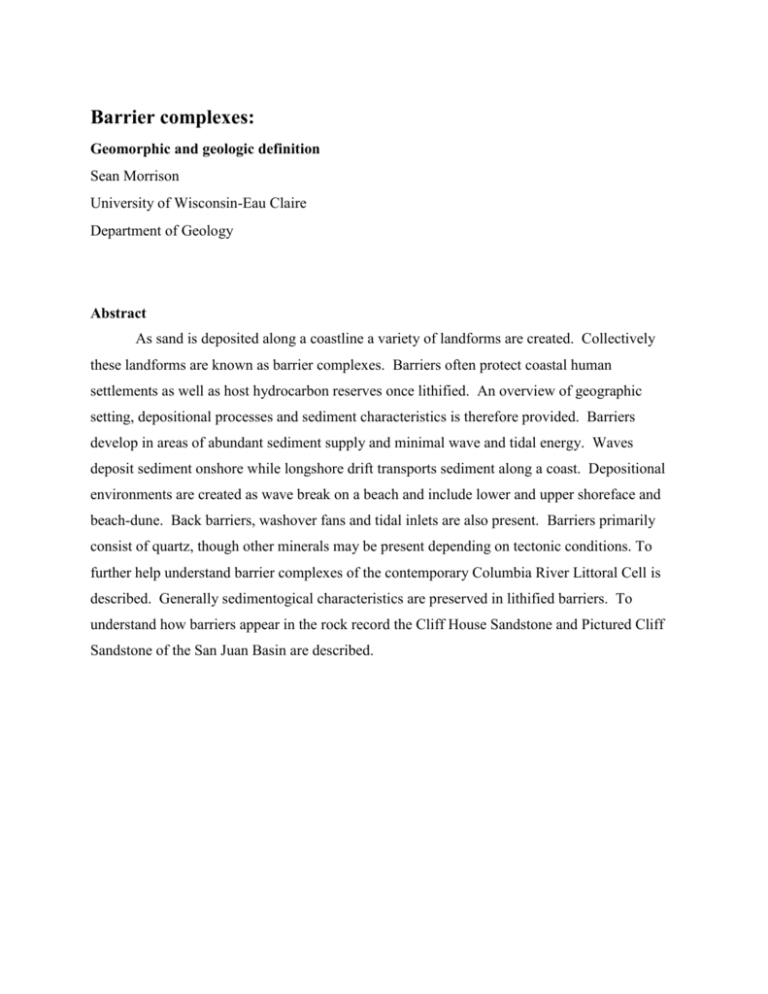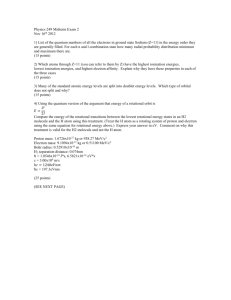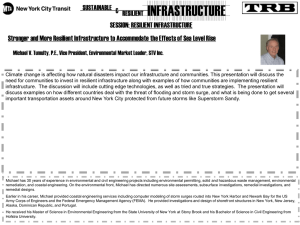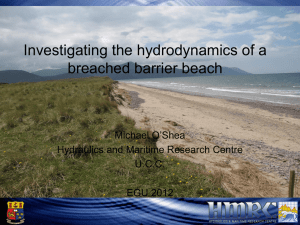
Barrier complexes:
Geomorphic and geologic definition
Sean Morrison
University of Wisconsin-Eau Claire
Department of Geology
Abstract
As sand is deposited along a coastline a variety of landforms are created. Collectively
these landforms are known as barrier complexes. Barriers often protect coastal human
settlements as well as host hydrocarbon reserves once lithified. An overview of geographic
setting, depositional processes and sediment characteristics is therefore provided. Barriers
develop in areas of abundant sediment supply and minimal wave and tidal energy. Waves
deposit sediment onshore while longshore drift transports sediment along a coast. Depositional
environments are created as wave break on a beach and include lower and upper shoreface and
beach-dune. Back barriers, washover fans and tidal inlets are also present. Barriers primarily
consist of quartz, though other minerals may be present depending on tectonic conditions. To
further help understand barrier complexes of the contemporary Columbia River Littoral Cell is
described. Generally sedimentogical characteristics are preserved in lithified barriers. To
understand how barriers appear in the rock record the Cliff House Sandstone and Pictured Cliff
Sandstone of the San Juan Basin are described.
Morrison1
Introduction
As littoral (near shore) processes redistribute sediments, a variety of landforms are
deposited. Siliclastic sediment is sorted and deposited as wave, tidal and wind processes interact
to form shore parallel linear barriers. These landforms are typically separated from the mainland
by a series of tidal flats, shallow bays, lagoons or marshes, collectively called the back barrier
(Davis and Fitzgerald, 2004). Barriers can be differentiated into barrier islands, spits (elongated
peninsulas), tombolos (spits connected two land pieces), and cuspates (triangular depositions
prograding in either direction)
based on their spatial morphology
(Figure 1). These configurations
show similar lateral and vertical
facies. Barriers also are important
for human development. Many of
the world’s greatest harbors provide
safe anchorage for ships because
they are protected by barrier
complexes. In addition tourists
often find the wide expanses of
beach sands on barrier complexes
(Figure 1).
Though spatial extent is
important to coastal engineers,
barrier facies are easiest to identify
in a stratigraphic sequence. This
paper will give a broad overview of
the processes that create barriers as
well as provide facies character of
active and sandstone barriers.
Figure 1: Aerial photographs with barrier landforms highlighted including,
lagoons, barrier islands, spits, tombolos, cuspate forelands. Barriers also serve to
protect many coastal human settlements from marine processes.
Morrison2
Geographic Extent
Barriers form in
littoral environments
where marine energy
and coastal morphology
are conductive to
barrier deposition.
Barrier complexes are
found worldwide
(Figure 2), they
preferentially develop
where wave and tidal
energy are low (Stutz
Figure 2: Barriers are found along the coastline of every continent except Antarctica. Most
barriers are found in low energy environments; however, barriers develop in any environment
with abundant sediment supplies. (From Stutz and Pilkey, 2011)
and Pilkey, 2011).
However, where sediment
supply is abundant enough
to outpace erosive wave
and tidal energy barriers
develop (Boggs, 2006).
Marine processes are the
primary drivers in barrier
deposition though
windblown processes play
a minor role in the
Figure 3: Map showing tidal amplitude. High tidal amplitude tends to create and erosive
environment. Barriers are most common in low tidal amplitude environments.
(http://upload.wikimedia.org/wikipedia/commons/5/5e/M2_tidal_constituent.jpg)
subaerially exposed
portions of the barrier (Davis and Fitzgerald, 2004). Depositional processes are largely
controlled by marine and tectonic environments.
Marine controls
The erosive power of marine processes are largely a function of wave and tidal energy.
High wave energy usually results in an erosive environment where most sediment is transported
Morrison3
and deposited offshore. Low wave energy results in the deposition of sand grains in the littoral
environment and barrier development (Davis and Fitzgerald, 2004).
In addition to waves, tides also play an important role in barrier development. Tides are
daily rises and falls in sea levels caused by the gravitational effect of the moon and sun on the
rotating earth. Tidal amplitude is a result of coastline morphology and deep ocean tidal patterns.
A high tidal range produces an erosive environment where sediment is transported offshore and
is not conducive to barrier development. Well developed, near continuous barriers are primarily
found where tidal range is small to moderate (Boggs, 2006) (Figure 3).
Tectonic Setting
Davis and
Fitzgerald (2004)
provide a detailed
description of
tectonic controls
which largely
govern sediment
supply and to a
lesser degree tidal
and marine energy.
Tectonic setting is
Figure 4: Barriers are most common along wide continental shelves (cyan) where tidal and wave
energy are low. Subduction zones have narrow continental shelves and are not conductive to
barrier development. (http://upload.wikimedia.org/wikipedia/commons/9/93/Elevation.jpg)
reflected in an area’s topography (Figure 4). Barriers preferentially develop along passive
continental margins. In these settings low relief coastal plains and continental shelves provide an
ideal environment for barrier deposition as low relief limits tidal energy. In addition abundant
sediment is supplied by extensive continental drainage. Marginal seas show little barrier
development. Though plentiful sediment is supplied from active uplift, irregular topography
leads to infilling of submarine valleys rather than barrier development. Collision coasts show
some barrier development, but only in areas of abundant sediment supply. Sediment is often
limited by small river drainage area, in addition, narrow, steep continental shelves are conducive
to high wave and tidal energy environments leading to rapid sediment dispersal.
Morrison4
Geomorphic Character
Before the geologic character can be discussed the geomorphic character must be
understood. Uniformitarnism is one of the fundamental principles of geology and states the
same natural laws that work on the earth today have always operated on the earth. The
fundamental tenet of this theory is that ancient sedimentary sequences were deposited in the
same fashion as modern sedimentary sequences. A firm understanding of depositional processes
and facies sequences of active barriers is therefore essential when studying sandstone barriers.
Sediment Deposition and Barrier Migration
Longshore drift
(process of transportation of
sediment along a coast)
dictates the direction of
sediment movement and
barrier migration along a
coast. The direction of
longshore drift is dictated
by wind direction. Waves
are pushed on shore by
wind energy, usually at an
angle. Sediment is pushed
Figure 5: Sediment transport along a coast dominate by longshore drift and wave action.
As wave approach shore sediment is moved onshore then returns offshore. In this manner
sediment is moved in a zig-zag manner in the direction of longshore drift.
(http://homertribune.com/wordpress/wp-content/uploads/2010/06/drift.gif)
up a beach with the wave then pulled back oceanward. Since the wave refracts perpendicular to
the shoreline sediment is pulled oceanward. Another wave then remobilizes the sediment
particles, pushing the sediment toward shore in the direction of the oncoming wave. Repetition
of this process moves sediment in along a coast in a zig-zag fashion and can cause a barrier to
migrate down current. (Figure 5) (Davis and Fitzgerald, 2004).
Depositional Environments
Barriers develop in response to changing sediment supply and sea level fluctuations.
Depositional processes vary in each area of a barrier system and are largely influenced by wave
action. The orbital pattern of wave motion compresses as the waves approach shore creating
several zones (Figure 6). The wave base is defined as depth at which a wave’s passage causes
significant water motion. The area above the mean fair weather wave base is termed the
Morrison5
shoaling zone and is further
subdivided into the surf and
breaker zones. As breaking
waves generate turbulence
they throw up suspension
sediment clouds as well as
cause a net landward
migration of bedload
sediment. The area of
Figure 6: Various zones are defined as a wave compresses and breaks as it approaches
shore. Beginning at the mean fairweather wave base a wave first enters the breaker
zone followed by the surf and swash zones. (From Boggs 2006)
sediment movement is the
called the surf zone. Furthest from shore, the breaker zone begins with the wave base and ends
at the surf zone. This area is dominated by oscillatory wave motion (Davis and Fitzgerald,
2004). Between the low and high tide line, the swash zone is dominated by sediment laden
swash up the beach and backwash off the beach. By using wave motion and relation to the
barrier several depositional environments can be defined (Figure 7).
a) Marsh-lagoonal – Marsh-lagoonal are deposited landward of the barrier and vary
depending on the exposure of the back barrier to the open ocean. Partial inundation of a
back barrier may result in an intertidal flat or salt marsh while total inundation of a back
barrier forms a lagoon or tidal creek (Davis and Fitzgerald 2004).
b) Washover Fans – When storm tides overtop beach-dune sediments is often eroded and
redeposit on top of marsh-lagoonal sediment. Channels facilitate the transport of large
amounts of sandy sediment into the back barrier. Repeated washover events coalesce
washover fans into large complex deposits (McCubbin, 1982).
c) Tidal Inlet channels – Inlet channels connect back barrier environments to the ocean and
range in depth from 4.5m to 40m. The size and spacing of inlet channels is dependent on
wave and tidal regime. Reversing tidal flow, waves and currents interact to deposit and
erode material in inlet channels. In deep channels seaward current dominates while
shallow channels are dominated by landward current. The ebb (oceanward) and flood
(landward) tidal deltas form at the outlet of tidal inlets based on dominate flow
characteristics (McCubbin, 1982).
Morrison6
d) Beach-dune – Wave
swash and windblown
processes dominate
beach-dune deposition.
Tides shift swash
laterally and vertically
on the beach while
wind may form dunes,
depending on
vegetation cover, above
the high tide line
(McCubbin, 1982).
e) Upper shoreface – The
surf zone and upper
breaker zone constitutes
the upper shoreface,
depth varies and is a
function of wave
amplitude (Davis and
Fitzgerald, 2004). This
zone is dominated by
Figure 7: Depositional zones in a barrier system. Depositional zone are primarily
dictated by wave patterns the protection provided by barrier system. Zones include
the back barrier, washover fans, tidal inlet channels, beach-dune, upper shoreface
and lower shoreface. (From McCubbin 1982)
oscillatory wave motion (McCubbin, 1982).
f) Lower shoreface – The lower breaker zone to the fair weather wave base is called the
lower shoreface which marks the transition between littoral and off shore processes. This
zone is dominated by low energy suspension settling (Davis and Fitzgerald, 2004).
Facies sequences
A complex set of facies are observed within barriers and reflect depositional processes.
Predominate facies include marsh-lagoonal, washover fan, tidal inlet channels, beach-dune,
upper and lower shoreface sediments (Figure 7 and Figure 8). The primary mineral in most
barriers is quartz since marine currents and wave action sort out most fine grain and liable
sediments (McCubbin, 1982). Facies thickness varies in high and low energy environments.
Morrison7
Generally upper and lower shoreface facies are thinner in low energy environments than high
energy environments where erosive processes move sediment from the beach and deposit it on
the upper shoreface (McCubbin, 1982).
a) Marsh-Lagoonal – Horizontal to subhorizontal interfingered sand, silt, mud and peat that
laterally grade to high energy sands near tidal channels, deltas and washover fans.
Commonly bioturbated with brackish water invertebrates (eg oysters) and plant remains
(Boggs, 2006).
b) Washover Fans – Horizontal to subhorizontal, may terminate with foreset sands,
decreasing thickness away from apex, bioturbation
in upper layer, oceanic debris also present.
Indvidual deposits can be 1m thick and extend
landward up to 300m, however, amalgamations of
several washover fans may create large, complex
deposits (McCubbin, 1982).
c) Tidal inlet – Thickness of sediment is dependent of
channel depth and may locally replace all other
beach facies. Generally, deposits consist of medium
to coarse grain and show a fining upward sequence.
Tabular, planar stratification dominates the channel
bottom. Spit migration follows longshore drift and
show trough shaped cross-stratification as well as
mega-ripple and large scale foresets. Mixed ocean
and marsh-lagoonal fauna may be present with
bioturbation. Ebb and flood tidal deltas are
characterized by ebb or flood oriented planar cross
stratification, depending on delta type and dominate
flow with small scale bidirectional, tough cross
Figure 8: Idealized cross-section of
beach-dune, upper shoreface and lower
shoreface grading to offshore and
continental shelf sediments in an active
barrier. (Modified from Boggs 2006)
stratification (McCubbin, 1982).
d) Beach-dune – Planar to seaward dipping (2̊-10̊) laminations, fine to medium sands, root
traces. Wedge shaped set commonly occur due to varying wave conditions (McCubbin,
Morrison8
1982). Windblown sands may be cross-stratified. Swash concentrates relatively coarse
particles as well as heavy minerals in thin laminations (Boggs, 2006).
e) Upper shoreface – Crossbedded laminations, Medium grading to fine sands, minor
bioturbation (Boggs, 2006). Trough bounded cross-stratification common and are
produced by the interaction of littoral currents and longshore drift (McCubbin 1982).
f) Lower shoreface –Fine sands grading to silts, extensive bioturbation (Boggs, 2006).
Ripples grading to horizontal to subhorizontal stratification. Individual beds may show
hummocky cross-stratification (McCubbin, 1982).
Modern example
Vanderburgh et al. (2010) and Peterson et al. (2010) sampled barriers within the
Columbia River Littoral Cell (CRLC) inferring much about its formation from the stratigraphy of
several barriers. Drill cores were primarily used to sample the barriers internal stratigraphy. In
addition ground penetrating radar was used to image the radar facies of the shallow subsurface.
The CRLC is located near the mouth of the Columbia River along the western margin of the
Figure 9: The Columbia River Littoral Cell (CRLC), near the
mouth of the Columbia River along the western margin of
North America shows many well developed barriers. (From
Peterson)
Figure 10: Several drill cores taken from various subcells
within the CRLC show the stratigraphy of barriers. (From
Peterson)
Morrison9
North American Plate (Figure 9). Sediment is supplied by the Columbia River and reworked by
wave, tidal and windblown processes. High wave energy from a thin continental shelf and
Pacific Ocean storms creates a broad zone of offshore sand mobilization while northward
longshore drift is generally responsible for sediment transport.
Stratigraphic sections for CRLC barriers are based on several drill cores (Figure 10) and
show typical barrier facies. Barrier facies begin with a laterally extensive, low gradient
ravinment surface that cuts underlying strata presumable from the transgression and erosion of
lowstand topography. In parts, this erosion deposited a thin, 0.25m-1.83m, transgressive lag of
rounded to subrounded gravels in a sand matrix with shell fragments, detrital wood and opaque
minerals. Lags often fine upward to sands. The dominant unit in CRLC barriers are shoreface
deposits, lower and upper shoreface deposits were not differentiated. These deposits range in
thickness from 8.0m on North Beaches to 26.0m on Clatsop Plains and consist of well sorted,
weakly layered dark gray fine to medium sands (with a man grain size of 0.20mm) with rare
mud-drape ripples. Scattered pebbles range in size from 4 to 10mm with infrequent wood and
shell fragments. Radar stratigraphic interpretation of ground penetrating radar (GPR)
differentiated beach-dune from shoreface deposits. A 1.7m on North Beaches to 15.5m on Long
Beach thick radar facies of seaward dipping clinoforms were interpreted as beach deposits.
The thickest barrier deposits were observed on Long Beach and Clatsop Plains (Figure
10), the barriers immediately adjacent to the Columbia River outlet and the main source of
sediment input (Figure 9). This emphasizes the importance to sediment supply in barrier
development. Even with high tidal energy (Figure 3) and wave energy from a narrow
continental shelf (Figure 4) a series of well-developed barriers has developed thanks to abundant
sediment supplied by the Columbia River with the largest barriers developing immediately
adjacent to the Columbia River outlet.
.
Geologic Character
The importance of the lithified coastal systems to human development cannot be under
stressed. Shifting shorelines often yield hydrocarbon producing units from stacked transgressive
and regressive barrier sequences. Ebb and flood-tide deltas associated with tidal inlets, overwash
fans and a shift in shoreface deposits often trap organic rich marsh-lagoonal source rock between
highly permeable sandstone units. Further tilting or anticline formation can then create a variety
Morrison10
of traps (Morse, 1994). The geomorphic
character of barrier facies are generally
preserved during lithification including
mineralogical and bedding characteristics
(Flores and Erpenbeck, 1981). However
transgressions (relative sea level rise) and
regressions (relative sea level fall) often
complicate the lateral and vertical facies in
barrier sandstones. During transgressions
barriers upper shoreface and beach-dune
deposits are eroded as a new barrier
develops along the new coastline. A new
Figure 12: The San Juan Basin in north-west New Mexico
located in Northwest New Mexico provides examples of
several lithified coastal systems.
(http://en.wikipedia.org/wiki/File:SanJuanBasinUSGS.jpg)
facies sequence generally develops ontop of
previously deposited marsh-lagoonal
sediments. Regressions often cause barriers
to prograde seaward as sea level falls
causing strandplain expansion and
preserving facies sequences as a barrier
builds outward (McCubbin, 1982).
The San Juan Basin in northwest
New Mexico (Figure 12) provides several
examples of lithified barrier systems. Units
were deposited in the foreland basin of the
Figure 13: Cross-section of San Juan Basin. Units were deposited
in the Cretaceous Inner Seaway. The Cliff House Sandstone was
deposited during a series of transgressive and regressive cycles.
The Pictured Cliff Sandstone was deposited during the final
regression of the Cretaceous Inner Seaway. (From Donselaar,
1988)
Cordilleran uplift along the shore of the Cretaceous Inner Seaway that connected the Gulf of
Mexico to the Arctic Ocean. The Upper Cretaceous Pictured Cliff and Cliff House Sandstone
(Figure 13) are believed to have been deposited during the final retreat of the Cretaceous Inner
Seaway during several transgressive and regressive cycles. Donselaar (1988) and Flores and
Erpenbeck (1981) describe lithic barrier sequences within the San Juan Basin. The units
described are the Cliff House and Pictured Cliff Sandstones respectively. Cliff House and
Pictured Cliffs Sandstone grades into the lower, non-marine Menefee and Fruitland Formations.
In the majority of the San Juan Basin the Pictured Cliff and Cliff House Sandstones are separated
Morrison11
by the offshore marine Lewis Shale but the sandstone units merge where the Lewis Shale
pinches out.
Cliff House Sandstone
Four stacked sandstone units in the Cliff House Sandstone identified as barrier complexes
(Figure 14) and described by Donselaar (1988).
Outcrops are exposed along Chaco Canyon,
New Mexico (Figure 15). The Cliff House Sandstone is a 90m thick, 9km wide, linear sandstone
complex composed of very fine grained to fine grained lithic arenite subdivided into four stacked
sandstone bodies. Marsh-lagoonal deposits are identified as Menfee Formation shale. Very fine
grained, cross bedded tidal inlet deposits are lenticular sandstone bodies with a slightly scoured
lower surface. Cross beds occur as 10-30 cm high sets. Washover fans occur as of horizontally
laminated sandstone sandstone units up to 30cm thick. Upper shoreface deposits are dominated
by parallel and cross-bedded very thickly bedded sandstones. Lower shoreface deposits occur as
bioturbated, cross-laminated, thickly to thinly bedded, horizontally bedded sandstone and grade
to offshore Lewis Shale deposits. Transgressions are marked by a sharp erosional surface
through marsh-lagoonal deposits Menefee Formation shale. Stacking of four barrier sandstone
units (Figures 14-15) are believed to represent a series of transgressions and regesions along the
Cretaceous Inner Seaway.
A model for the stacking of transgressive and regressive units in proposed from
interpretation and analysis of sandstone bodies. While during regression sediment is deposited
and a coarsening upward barrier facies sequence develops. Transgression are marked by a sharp
Figure 14: Inferred depositional environment of stacked
sandstone bodies within the Cliff House Sandstone and
associated Lewis Shale (Kl), Menefee Formation (Kmf) and
La Ventana Tongue of the Cliff House Sandstone (Kchlv).
(From Donselaar, 1988)
Figure 15: Modern setting of Cliff House Sandstone across several transects
of Chaco Canyon, NM. Stacked sandstone bodies 1-4 correspond to
sandstone bodies in Figure 13 (From Donselaar, 1988).
Morrison12
erosional contact. Upper deposits are often eroded away, preserving shoreface and marshlagoonal deposits. Four sandstone bodies are differentiated by the identification of sharp
erosional contact surfaces and the deposition of lower shoreface sediment on top of the
previously deposited sediment. Cliff House sandstone stratigraphy shore four stacked barrier
sequences (Figure 17) representing four regressive sequences during relative sea-level rise
during the Cretaceous.
Figure 17: Stratigraphic columns of several section of the Cliff House Sandstone exposed near Chaco Canyon.
Morrison13
Pictured Cliff Sandstone
Barrier lithofacies within the Pictured Cliff Sandstone are described by Flores and
Erpenbeck (1981) and represent the final regression of the Cretaceous Inner Seaway. In general
a coarsening upward sequence from very fine to medium grain quartz. Mineral composition
averages 43% (in upper units) to 74% (in lower units) quartz, 14% feldspar, 4% mica fragments
and 20% lithics. Lower shoreface deposits consist of interbedded sandstones, siltstones and
shales ranging in thickness from a few millimeters to 1.5m and grade downward into Lewis
Shale which likely represents offshore deposition. In general, lower shoreface sediments are
dark gray, laminated and show ripple lamininations where not bioturbated by skolithos or
Figure 18: Cross-sections of barriers within the Pictured Cliff Sandstone (From Flores and Erpenbeck, 1981)
ophiomopha burrows. Grain size ranges from silt to fine grain. The upper shoreface is light gray
where unweathered with low angle crossbeds and locally bioturbated and ranges in thickness
form 6m to 9.5m. Grain size ranges from fine to medium grain. Beach-dune deposits are light
gray showing parallel to subparallel laminations that locally grade to crossbeds and ripple
laminations with intense sparsely to locally ophiomorpha burrows. Deposits range in thickness
from 4.5m to 6m. Grain size ranges from fine grain in the lower part of the unit to medium grain
in the upper part of the unit. Rare washover fan deposits occur in the overlying back-barrier
Fruitland Formation. Tidal inlet deposits occur as 2.5km wide elongate deposits with a thickness
of 11m. Lenticular and foreset laminations with some ripple laminations and ophiomorpha
burrows occur within the deposits. Lower units contains fine grains with shale and siltstone lag
clasts grading to medium grains (Figure 18).
The size of coal beds in the overlying Fruitland Formation is determined by their
association with barrier and delta-plain deposition in the Pictured Cliff Sandstone. Thin coal
Morrison14
beds, 0.6m thick, in the lower Fruitland Formation represent back barrier deposition. Thicker,
economic coal beds are found in delta-plain deposits. The identification of delta-plain versus
barrier deposits in the Pictured Cliff Sandstone can therefore be used to determine the nature of
overlying coal deposits.
Conclusion
Hydrocarbon reservoirs and the protection barriers offer to coastal human settlements
make barriers one of the most important depositional environments on the earth’s surface.
Siliclastic barriers develop from the interaction of wave and tidal, and to a lesser extent
windblown, processes. Barriers most often occur where wave and tidal energy is low and
sediment input is high. As waves break against the shoreline they create a variety of depositional
environments including, lower and upper shoreface and beach-dune. In addition marsh-lagoonal,
washover fans and tidal inlets are defined by their association with the main barrier. The
Columbia River Littoral Cell provides an example of a modern depositional environment and
emphasizes the importance of sediment input to barrier development. The Cliff House and
Pictured Cliff Sandstone provides an example of an ancient barrier complex and the show the
complications in barrier facies that arise from regressive and transgressive phases and the
importance of barrier complexes in hydrocarbon reserves.
References
Boggs, S., 2006, Principles of Sedimentology and Stratigraphy, 5th ed., Pearson Prentice Hall, p. 260-267.
Davis, R. A. and Fitzgerald, D. M., 2004, Beaches and Coasts: Massachusetts, Blackwell Science Ltd., p. 101-167.
Donselaar, M. E., 1988, The Cliff House Sandstone, San Juan Basin, New Mexico; model for the stacking of
"transgressive" barrier complexes: Journal of Sedimentary Petrology, v. 59, no. 1, p. 13-27.
Flores, R. M., and Erpenbeck, M. F., 1981, Differentiation of delta-front and barrier lithofacies of the Upper
Cretaceous Pictured Cliffs Sandstone, southwest San Juan Basin, New Mexico: The Mountain Geologist, v.
18, no. 2, p. 23-34.
McCubbin, D., 1982, Barrier-Island and Strand-Plain Facies: Sandstone Depositional Environments: AAPG Memoir
31, p. 247-280.
Morse, D.G., 1994, Siliclastic Reservoir Rocks: The petroleum system – from source to trap:AAPG Memoir 60, p.
121- 140.
Peterson, C. D., Vanderburgh, S., Roberts, M. C., Jol, H. M., Phipps, J., and Twichell, D. C., 2010, Composition,
age, and depositional rates of shoreface deposits under barriers and beach plains of the Columbia River
littoral cell, USA: Marine Geology, v. 273, no. 1-4, p. 62-82.
Stutz, M. L. and Pilkey, O.H., 2011, Open-Ocean Barrier-Islands: Global Influence of Climatic, Oceanographic, and
Depositional Settings: Journal of Coastal Research vol. 27, iss. 2, pp. 207-222.
Vanderburgh, S., Roberts, M. C., Peterson, C. D., Phipps, J. B., and Herb, A., 2010, Transgressive and regressive
deposits forming the barriers and beachplains of the Columbia River Littoral Cell, USA: Marine Geology,
v. 273, no. 1-4, p. 32-43.










